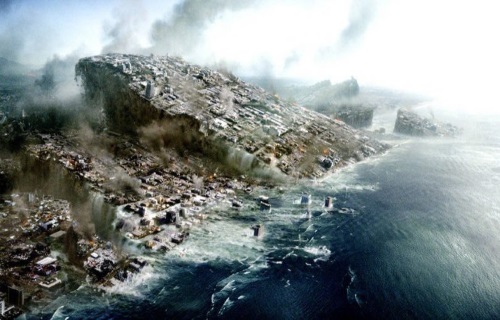by Amy S.

A major earthquake measuring magnitude 6.4, has struck in the Cascadia Subduction Zone off the coast of Oregon. The quake took place at 11:08 AM eastern US time Thursday at a very shallow depth of only 12km.
This is an extremely dangerous development. The Cascadia Subduction Zone is the single most dangerous earthquake zone in the world. A large rupture of this zone would send Tsunamis into the US west coast, destroying everything west of Interstate 5.
TO have this magnitude quake strike so suddenly is a bad sign or potential worse to come.
At depths shallower than 30 km or so, the CSZ is locked by friction while strain slowly builds up as the subduction forces act, until the fault’s frictional strength is exceeded and the rocks slip past each other along the fault in a “megathrust” earthquake. The fault’s frictional properties change with depth, such that immediately below the locked part is a strip (the “Transition Zone”) that slides in “slow slip events” that slip a few cm every dozen months or so. This relieves the plate boundary stresses there, but adds to the stress on the locked part of the fault. Below the transition zone geodetic evidence suggests that the fault slides continuously and silently at long term plate slip rate. From its surface trace offshore to a depth of possibly 5 km, all remote from land, observations are few and it remains unknown whether the fault is stuck or slipping silently.
Great Subduction Zone earthquakes are the largest earthquakes in the world, and are the only source zones that can produce earthquakes greater than M8.5. The CSZ has produced magnitude 9.0 or greater earthquakes in the past, and undoubtedly will in the future.
The last known megathrust earthquake in the northwest was in January, 1700, just over 300 years ago. Geological evidence indicates that such great earthquakes have occurred at least seven times in the last 3,500 years, a return interval of 400 to 600 years. To learn more about the history of the Cascadia Subduction Zone and the science that led to the discovery of it, delve into land level changes and turbidites created by the CSZ earthquakes. For more about the Cascadia Subduction Zone, visit the USGS webpage discussing this topic.
The CSZ may be unique among the worlds subduction zones in that it produces very few (if any) earthquakes unambiguously on the plate interface. Coupled with evident occurrence of great megathrust earthquakes, the CSZ must be much more strongly locked than other subduction faults. The geological evidence has led to different interpretrations, moreover, about whether the entire CSZ always ruptures in great M9 earthquakes, or whether smaller M8 or M8.5-sized events also can break parts of the zone in between the full rupture events.
The M9 Project is a team of experts whose goal is to reduce catastrophic potential effects of a Cascadia megathrust earthquake on social, built, and natural environments through the advancement of methodologies, early warnings, and community planning.
The challenges start with assessing the range of distributions of fault motion and, therefore, the shaking and tsunamis that the Cascadia fault might generate. The project addresses factors not previously considered, including the distribution and timing of energy release on the fault, the coherent variation of frequency content of fault motion with fault depth, and the 3D effects of the deep basins along Puget Sound—and will specify the uncertainty in the estimated motions, which is critical to probabilistic estimation of earthquake impact, including liquefaction, landslides, tsunamis, and built infrastructure response.
The project will develop new probabilistic, statistical, and numerical methodologies to provide deeper insight into these phenomena. The project’s research will improve forecasting of landslides and liquefaction through better resolution of the underlying physics with recent data from Japan and Chile. It will also improve estimation of tsunami effects by developing more realistic scenarios of seafloor deformation and by estimating the battering power of entrained debris. Built-environment response to the unique long-period and long-duration ground motions will be evaluated probabilistically using advanced numerical simulation. To inform the development and deployment of earthquake early warning in the U.S., the project includes interview and survey research on the potential effects of messages that provide just a few seconds or minutes of warning. With local communities and agency partners, the project will improve the utility of probabilistic information by comparing how stakeholders interpret (a) single “worst case” hazard scenarios and (b) multiple probabilistic scenarios, and how each type of scenario is then incorporated into community emergency preparedness and long-range planning. The project will also advance the integration of probabilistic assessments into hazards education.
The last decade has provided unexpected lessons in the enormous risks from giant subduction earthquakes of M9. Sumatra 2004, Chile 2010, and Japan 2011 each caused devastation that took scientists and residents by surprise. M9 earthquakes in the Cascadia subduction zone pose the greatest natural hazard in the Pacific Northwest and provide an integrative focus for interdisciplinary research on reducing future losses to extreme events. To address challenges in risk reduction, this project brings together experts from academia, government, and other nonprofit organizations. The shared vision is to reduce the catastrophic risk of a Cascadia M9 earthquake through integrated advances in forecasting, warning and adaptive planning across the social, built and natural environments. The project will move beyond generalized scenarios toward probabilistic predictions of M9 seismic events and the subsequent hazards, with the objective of integrating these into community resilience planning and advancing the state of earthquake early warning systems.